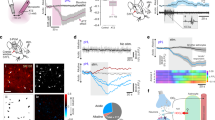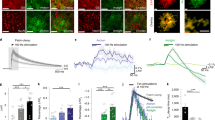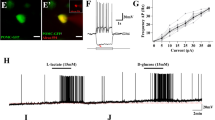Abstract
L-glutamic acid (L-Glu) and L-aspartic acid (L-Asp) are considered to be major excitatory amino acid transmitters, causing depolarization and excitation of neurones in the mammalian central nervous system (CNS)1,2. These responses have been thought to be an exclusively neuronal property as the excitatory amino acids either did not affect the potential of electrophysiologically unresponsive glial cells3,4, or when an effect was seen, it was attributed to changes in external [K+] (refs 5, 6). Here we report that L-Glu directly depolarizes immunocytochemically-identified astrocytes in primary culture. L- or D-Asp and kainic acid (KA) also depolarized these cells while none or minimal changes in the resting membrane potentials were found in response to N-methyl-D-aspartate, D-glutamate, taurine, L-glutamine or to the inhibitory amino acids γ-aminobutyric acid (GABA) and glycine. We conclude that the membrane potential of astrocytes can no longer be thought of as being responsive only to K+ and that the electrophysiological effects of excitatory amino acids in situ may not be exclusively a neuronal property.
This is a preview of subscription content, access via your institution
Access options
Subscribe to this journal
Receive 51 print issues and online access
$199.00 per year
only $3.90 per issue
Buy this article
- Purchase on Springer Link
- Instant access to full article PDF
Prices may be subject to local taxes which are calculated during checkout
Similar content being viewed by others
References
Watkins, J. C. & Evans, R. H. A. Rev. Pharmac. Tox. 21, 165–204 (1981).
Watkins, J. C. in Glutamate: Transmitter in the Central Nervous System (eds Storm-Mathisen, J. & Johnston, B. W.) 1–24 (Wiley, Ltd., Chichester, 1981).
Krnjevic, K. & Schwartz, S. Expl Brain Res. 3, 306–319 (1967).
Wardell, W. M. Proc. R. Soc. 165, 326–361 (1966).
Hosli, L., Andres, F. & Hosli, E. Neuroscience 4, 1593–1598 (1979).
Hosli, L. & Hosli, E. in Glutamine, Glutamate and GABA in the Central Nervous System (eds Hertz, L., Kvamme, E., McGeer, E. G. & Schousboe, A.) 441–455 (Alan R. Liss, Inc., New York, 1983).
McCarthy, K. D. & Harden, T. K. J. Pharmac. exp. Ther. 216, 183–191 (1981).
Bignami, A., Dahl, D. & Rueger, D. in Advances in Cellular Neurobiology (eds Federoff, S. & Hertz, L.) 285–310 (Academic, London 1980).
Eng, L. F. in Proteins of the Nervous System (eds Bradshaw, R. & Schneider, D.) 85–117 (Raven, New York, 1980).
Kimelberg, H. K. Cell Molec. Neurobiol. 3, 1–16 (1983).
Bowman, C. L., Kimelberg, H. K., Frangakis, M. V., Berwald-Netter, Y. & Edwards, C. J. Neurosci. 4, 1527–1534 (1984).
Schousboe, A., Svenneby, G. & Hertz, L. J. Neurochem. 29, 999–1005 (1977).
Fonnum, F. J. Neurochem. 42, 1–11 (1984).
Kimelberg, H. K. et al. in Head Injury: Basic and Clinical Aspects (eds Grossman, R. & Gildenberg, P. L.) 31–44 (Raven, New York, 1982).
Kimelberg, H. K., Bowman, C. L., Biddlecome, S. & Bourke, R. S. Brain Res. 177, 533–550 (1979).
Thomas, R. C. Physiol. Rev. 52, 563–594 (1972).
Constanti, A. & Galvin, M. Brain Res. 153, 183–187 (1978).
Tang, C.-M. thesis. Univ. Pennsylvania (1982).
Villegas, J. in Dynamic Properties of Glia Cells (eds Schoffeniels, E., Franck, G., Hertz, L. & Tower, D. B.) 207–215 (Pergamon, New York, 1978).
Van Calker, D. & Hamprecht, B. in Advances in Cellular Neurobiology Vol. 1 (eds Federoff, S. & Hertz, L.) 31–67 (Academic, New York, 1980).
Evans, T., McCarthy, K. D. & Harden, T. K. J. Neurochem. 43, 131–138 (1984).
Ebersolt, C., Perez, M. & Bockaert, J. J. Neurosci. Res. 6, 643–652 (1981).
Repke, H. & Maderspach, K. Brain Res. 232, 206–211 (1982).
Trimmer, P. A., Evans, T., McCardy, M. S. & Harden, T. K. J. Neurosci. 4, 1598–1606 (1984).
Hosli, L., Hosli, E., Zehntner, C., Lehmann, R. & Lutz, T. W. Neuroscience 7, 2867–2872 (1982).
Hirata, H., Slater, N. T. & Kimelberg, H. K. Brain Res. 270, 358–362 (1983).
Kuffler, S. W., Nicholls, J. G. & Orkand, R. K. J. Neurophysiol. 29, 768–787 (1966).
Kimelberg, H. K., Stieg, P. E. & Mazurkiewicz, J. J. Neurochem. 39, 734–742 (1982).
Frangakis, M. V. & Kimelberg, H. K. Neurochem. Res. 9, 1685–1694 (1984).
Banker, G. A. & Cowan, W. M. Brain Res. 126, 397–425 (1977).
Author information
Authors and Affiliations
Rights and permissions
About this article
Cite this article
Bowman, C., Kimelberg, H. Excitatory amino acids directly depolarize rat brain astrocytes in primary culture. Nature 311, 656–659 (1984). https://doi.org/10.1038/311656a0
Received:
Accepted:
Issue Date:
DOI: https://doi.org/10.1038/311656a0
This article is cited by
-
Preface for the Vladimir Parpura Honorary Issue of Neurochemical Research
Neurochemical Research (2021)
-
NMDA Receptors in Astrocytes
Neurochemical Research (2020)
-
Glutamate Transporters and Mitochondria: Signaling, Co-compartmentalization, Functional Coupling, and Future Directions
Neurochemical Research (2020)
-
A review of functional heterogeneity among astrocytes and the CS56-specific antibody-mediated detection of a subpopulation of astrocytes in adult brains
Anatomical Science International (2018)
-
Glutamate and ATP at the Interface Between Signaling and Metabolism in Astroglia: Examples from Pathology
Neurochemical Research (2017)
Comments
By submitting a comment you agree to abide by our Terms and Community Guidelines. If you find something abusive or that does not comply with our terms or guidelines please flag it as inappropriate.



